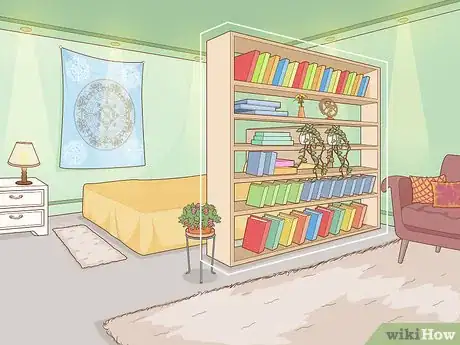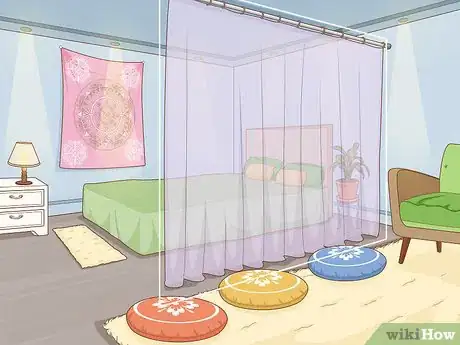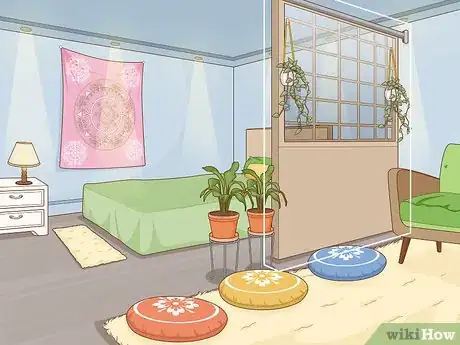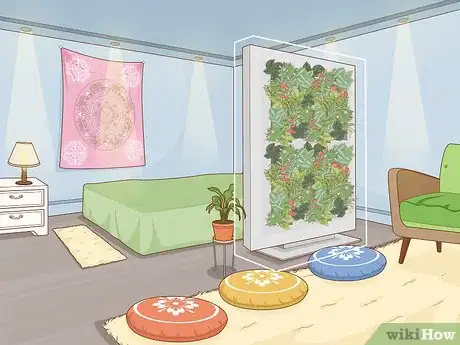This article was co-authored by MacKenzie Cain. MacKenzie Cain is an Interior Designer and a LEED-certified Green Associate for Habitar Design based in Chicago, Illinois. She has over seven years of experience in interior design and architectural design. She received a BA in Interior Design from Purdue University in 2013 and received her LEED Green Associate certification from the Green Building Certification Institute in 2013.
There are 8 references cited in this article, which can be found at the bottom of the page.
This article has been viewed 32,228 times.
Small living spaces make it hard to find privacy, but they also present an opportunity for you to get creative with your living arrangement. Using furniture or colorful curtains to divide a room can add life to your space while serving a useful purpose. Or, you can get into a more involved DIY project to create separation while showing off your style. Celebrate your love of movies by installing a projector screen, bring some life into your apartment with a green wall, or make a music-lovers' corner with a vinyl record curtain. With these options, you can keep your living room and bedroom separate while giving your home personality.
Steps
Getting Creative with Furniture
-
1Use a tall piece of furniture, like a bookshelf or dresser, to divide the room. Placing a piece of furniture at the foot or along the side of your bed will give you some privacy. It also has the added benefit of adding storage space to either your bedroom or living room space.[1]
- To maximize privacy, look for furniture that is almost as tall as your ceilings.
-
2Place the head of your bed next to a paneled room divider. Something as simple as a few panels of screen, wood, or bamboo can be a quick and effective way to divide a room. You can buy paneled dividers at hardware and home goods stores.
- Use a divider as-is, or customize it to make your divider into a piece of home decor.
Advertisement -
3Place the back of a couch against the foot of your bed. With this arrangement, you won't see your bedroom space while sitting on the couch, creating separation without needing any additional furniture. You can make the spaces even more visually distinct by using an area rug in each space, or by choosing different color schemes for the bedroom and the living room.[2]
-
4Use a garment rack to display your fashion sense and create a divide. Hang a bar from the ceiling, or purchase a clothing or garment rack from a home goods store to display the best of your closet. You can also display accessories like shoes and hats and add a standing mirror to fill out your display into a freestanding closet.[3]
- Use a color scheme that fits with your decor to make the display look more intentional.
- Complete the look with matching clothes hangers.
Creating DIY Partitions
-
1Make use of any natural divisions the room already has. If you have a nook, or even a large closet, place your bed inside. For extra privacy, add a curtain, shelf, or partition to hide the bed from the rest of the space.[4]
-
2Hang a curtain partition across the room. Use either a ceiling-mounted curtain rod or aircraft cable to hang curtain across the length of the room. Secure the brackets or ends of the cable with anchors in the drywall, especially if the curtain is heavy.[5]
- Once you have installed the curtain, you can adjust it to be partly open or completely closed, making this one of the most adjustable options for privacy.
-
3Install a projector screen. Hang a projector screen from the ceiling between your bed and your living space. Depending on the kind of projector you are using, either mount it on your ceiling as well, or place it on a sturdy surface the correct distance from the screen. Follow the manufacturer's instructions.[6]
- Projector screens don't work well in brightly lit spaces, so choose a spot for it away from windows, if possible.
- Some projector screens are visible from both sides, so look for this feature if you'd like to enjoy your movies from both the living room and the bedroom.
-
4Salvage doors and windows to create a unique partition. Look around at your local thrift stores or flea markets to find discarded doors and windows. Customize them to fit with your decor style with a coat of paint, or leave them as-is for a more rustic look.
- Be careful when salvaging to check for broken glass or splinters. You may have to sand down old wood.[7]
-
5Use shipping pallets to make a room divider. This can be as easy as standing one or two shipping pallets vertically next to your bed, or you can customize them to your liking. Add paint, or hang photos, prints, and posters from the panels. Either way, the design of shipping pallets lets light into your bedroom space while also giving you privacy.[8]
- As with salvaged wood doors and windows, be sure to sand down rough wood so you don't get splinters.
-
6Hang old vinyl LPs from the ceiling to make a curtain. Attach old records by drilling four holes around the edges, and threading string or metal rings through the holes. Hang them from the ceiling. Leave the records as they are, or paint them to brighten up your space.[9]
-
7Create your own green wall. Use a shelving system or hang plants strategically from the ceiling to create a partition while bringing plant life into your home. Choose plants that work well for your space and learn how to take care of plants.[10]
Expert Q&A
Did you know you can get expert answers for this article?
Unlock expert answers by supporting wikiHow
-
QuestionHow do you separate a room without a wall?
 MacKenzie CainMacKenzie Cain is an Interior Designer and a LEED-certified Green Associate for Habitar Design based in Chicago, Illinois. She has over seven years of experience in interior design and architectural design. She received a BA in Interior Design from Purdue University in 2013 and received her LEED Green Associate certification from the Green Building Certification Institute in 2013.
MacKenzie CainMacKenzie Cain is an Interior Designer and a LEED-certified Green Associate for Habitar Design based in Chicago, Illinois. She has over seven years of experience in interior design and architectural design. She received a BA in Interior Design from Purdue University in 2013 and received her LEED Green Associate certification from the Green Building Certification Institute in 2013.
Interior Designer & LEED Green Associate If you want to use a room in two different ways, you need furniture pieces that can also be used in different ways. For example, a day bed can be used as a sofa and a bed. Murphy beds are also a great option for multi-function spaces, because they can be tucked away during the day and pulled down when you need them at night.
If you want to use a room in two different ways, you need furniture pieces that can also be used in different ways. For example, a day bed can be used as a sofa and a bed. Murphy beds are also a great option for multi-function spaces, because they can be tucked away during the day and pulled down when you need them at night.
References
- ↑ https://makespace.com/blog/posts/ways-to-divide-a-studio-apartment/
- ↑ https://makespace.com/blog/posts/ways-to-divide-a-studio-apartment/
- ↑ https://www.apartmenttherapy.com/how-to-create-a-separate-bedroom-in-a-studio-apartment-240109
- ↑ https://www.apartmenttherapy.com/how-to-create-a-separate-bedroom-in-a-studio-apartment-240109
- ↑ https://www.apartmenttherapy.com/how-to-hang-curtains-across-an-829
- ↑ https://www.diynetwork.com/how-to/rooms-and-spaces/home-theater/how-to-install-a-ceiling-mounted-projector-screen
- ↑ https://www.bobvila.com/slideshow/divide-and-conquer-17-room-dividers-to-bring-order-to-your-space-44560#door-room-divider
- ↑ https://www.bobvila.com/slideshow/divide-and-conquer-17-room-dividers-to-bring-order-to-your-space-44560#pallet-room-divider
- ↑ https://www.bobvila.com/slideshow/divide-and-conquer-17-room-dividers-to-bring-order-to-your-space-44560#vinyl-record-diy






































































